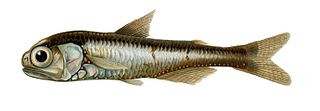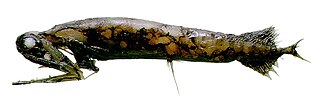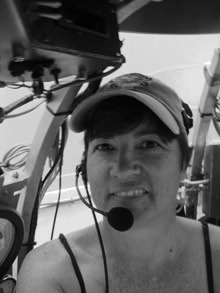
Deep-sea fish are animals that live in the darkness below the sunlit surface waters, that is below the epipelagic or photic zone of the sea. The lanternfish is, by far, the most common deep-sea fish. Other deep sea fishes include the flashlight fish, cookiecutter shark, bristlemouths, anglerfish, viperfish, and some species of eelpout.

Bioluminescence is the production and emission of light by a living organism. It is a form of chemiluminescence. Bioluminescence occurs widely in marine vertebrates and invertebrates, as well as in some fungi, microorganisms including some bioluminescent bacteria, and terrestrial arthropods such as fireflies. In some animals, the light is bacteriogenic, produced by symbiotic bacteria such as those from the genus Vibrio; in others, it is autogenic, produced by the animals themselves.

The Squaliformes are an order of sharks that includes about 126 species in seven families.

Stomiiformes is an order of deep-sea ray-finned fishes of very diverse morphology. It includes, for example, dragonfishes, lightfishes, loosejaws, marine hatchetfishes and viperfishes. The order contains 4 families with more than 50 genera and at least 410 species. As usual for deep-sea fishes, there are few common names for species of the order, but the Stomiiformes as a whole are often called dragonfishes and allies or simply stomiiforms.

A photophore is a glandular organ that appears as luminous spots on various marine animals, including fish and cephalopods. The organ can be simple, or as complex as the human eye; equipped with lenses, shutters, color filters and reflectors, however unlike an eye it is optimized to produce light, not absorb it. The bioluminescence can variously be produced from compounds during the digestion of prey, from specialized mitochondrial cells in the organism called photocytes, or, similarly, associated with symbiotic bacteria in the organism that are cultured.

Lanternfishes are small mesopelagic fish of the large family Myctophidae. One of two families in the order Myctophiformes, the Myctophidae are represented by 246 species in 33 genera, and are found in oceans worldwide. Lanternfishes are aptly named after their conspicuous use of bioluminescence. Their sister family, the Neoscopelidae, are much fewer in number but superficially very similar; at least one neoscopelid shares the common name "lanternfish": the large-scaled lantern fish, Neoscopelus macrolepidotus.

Pelagic fish live in the pelagic zone of ocean or lake waters – being neither close to the bottom nor near the shore – in contrast with demersal fish that do live on or near the bottom, and reef fish that are associated with coral reefs.
The deep sea or deep layer is the lowest layer in the ocean, existing below the thermocline and above the seabed, at a depth of 1000 fathoms or more. Little or no light penetrates this part of the ocean, and most of the organisms that live there rely for subsistence on falling organic matter produced in the photic zone. For this reason, scientists once assumed that life would be sparse in the deep ocean, but virtually every probe has revealed that, on the contrary, life is abundant in the deep ocean.

Stomiidae is a family of deep-sea ray-finned fish, including the barbeled dragonfishes. They are quite small, usually around 15 cm, up to 26 cm. These fish are apex predators and have enormous jaws filled with fang-like teeth. They are also able to hinge the neurocranium and upper-jaw system, which leads to the opening of the jaw to more than 100 degrees. This ability allows them to consume extremely large prey, often 50% greater than their standard length.

The stoplight loosejaws are small, deep-sea dragonfishes of the genus Malacosteus, classified either within the subfamily Malacosteinae of the family Stomiidae, or in the separate family Malacosteidae. They are found worldwide, outside of the Arctic and Subantarctic, in the mesopelagic zone below a depth of 500 meters. This genus once contained three nominal species: M. niger, M. choristodactylus, and M. danae, with the validity of the latter two species being challenged by different authors at various times. In 2007, Kenaley examined over 450 stoplight loosejaw specimens and revised the genus to contain two species, M. niger and the new M. australis.

The deep sea fish, Malacosteus niger, is commonly known as the Black Dragon Fish. Some additional common names for this species include: Northern Stoplight Loosejaw, Lightless Loosejaw, Black Loosejaw, and Black Hinged-Head. It belongs to the order of fishes called the dragonfishes, or scientifically known as the Stomiidae. It is among the top predators of the open mesopelagic zone. M. Niger is a circumglobal species, which means that it inhabits waters ranging from the tropics to the subarctics. Not many studies have been conducted on its feeding habits, but recent research suggests that M. niger primarily feed on a calanoid copopods which is a form of zooplankton. Indeed, it appears that M. niger primarily prey on zooplankton despite its apparent morphological adaptations for the consumption of relatively large prey. Another unique adaptation for this species is its ability to produce both red and blue bioluminescence. Most mesopelagic species aren’t capable of producing red bioluminescence. This is advantageous because most other species cannot perceive red light, therefor allowing M. niger to camouflage part of itself to its prey and predators.

Sloane's viperfish, Chauliodus sloani, is a predatory, mesopelagic dragonfish found in deep-pelagic waters across the world. The species was first described by German scientists Marcus Elieser Bloch and Johann Gottlob Schneider in their 1801 book Systema ichthyologiae: iconibus CX illustratum, volume 1. Its size can range from 64 mm to 260 mm, and it is an iridescent silver-blue color. It has two rows of photophores, one on each side of the ventral part of its body. It is believed that C. sloani adjusts the intensity of ventral photophores during diurnal migrations to camouflage itself from predators that might see its shadow from below.

Biological pigments, also known simply as pigments or biochromes, are substances produced by living organisms that have a color resulting from selective color absorption. Biological pigments include plant pigments and flower pigments. Many biological structures, such as skin, eyes, feathers, fur and hair contain pigments such as melanin in specialized cells called chromatophores. In some species, pigments accrue over very long periods during an individual's lifespan.

A deep sea community is any community of organisms associated by a shared habitat in the deep sea. Deep sea communities remain largely unexplored, due to the technological and logistical challenges and expense involved in visiting this remote biome. Because of the unique challenges, it was long believed that little life existed in this hostile environment. Since the 19th century however, research has demonstrated that significant biodiversity exists in the deep sea.

The term deep sea creature refers to organisms that live below the photic zone of the ocean. These creatures must survive in extremely harsh conditions, such as hundreds of bars of pressure, small amounts of oxygen, very little food, no sunlight, and constant, extreme cold. Most creatures have to depend on food floating down from above.
Malacosteus australis, the southern stoplight loosejaw, is a species of barbeled dragonfish. This species is mainly distinguished from Malacosteus niger by a smaller postorbital photophore in both sexes and lower numbers of lateral photophores. It also differs in having somewhat smaller jaws, a fleshy orbit, and several subtle morphological traits. The maximum known length is 253.2 mm. Its specific epithet comes from the Latin austral, meaning "southern". It is known for its red bioluminescence which helps M. australis visualize in the aphotic deep sea.

Edith Anne "Edie" Widder Smith is an American oceanographer, marine biologist, author and the Co-founder, CEO and Senior Scientist at the Ocean Research & Conservation Association.

Underwater camouflage is the set of methods of achieving crypsis—avoidance of observation—that allows otherwise visible aquatic organisms to remain unnoticed by other organisms such as predators or prey.

Counter-illumination is a method of active camouflage seen in marine animals such as firefly squid and midshipman fish, and in military prototypes, producing light to match their backgrounds in both brightness and wavelength.

Neoscopelus macrolepidotus, also known as a large-scaled lantern fish, is a species of small mesopelagic or bathypelagic fish of the family Neoscopelidae, which contains six species total along three genera. The family Neoscopelidae is one of the two families of the order Myctophiformes. Neoscopelidae can be classified by the presence of an adipose fin. The presence of photophores, or light-producing organs, further classify the species into the genus Neoscopelus. N. macrolepidotus tends to be mesopelagic until the individuals become large adults, which is when they settle down to the bathypelagic zone.


















